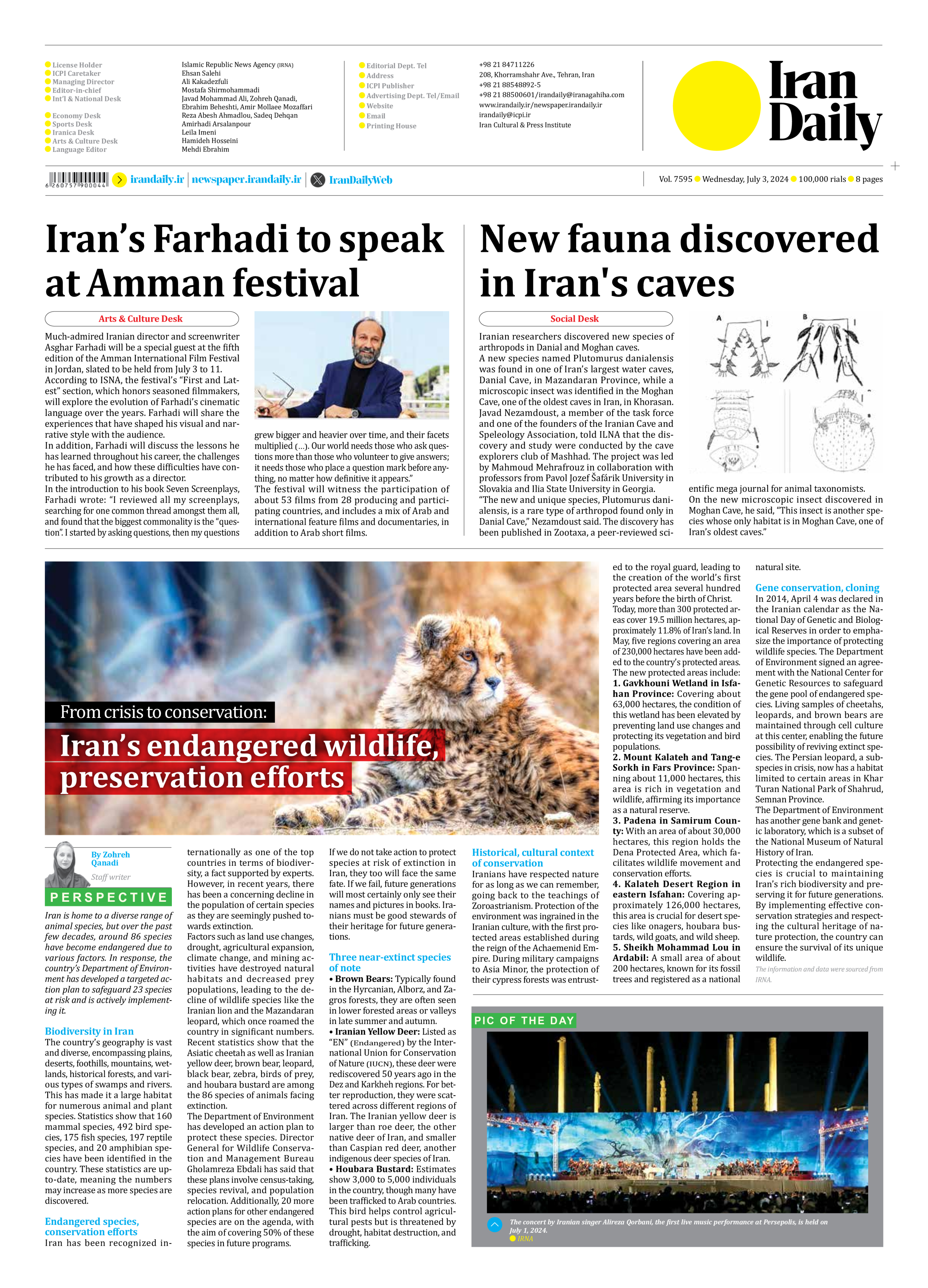
From crisis to conservation:
Iran’s endangered wildlife, preservation efforts
Iran is home to a diverse range of animal species, but over the past few decades, around 86 species have become endangered due to various factors. In response, the country’s Department of Environment has developed a targeted action plan to safeguard 23 species at risk and is actively implementing it.
Biodiversity in Iran
The country’s geography is vast and diverse, encompassing plains, deserts, foothills, mountains, wetlands, historical forests, and various types of swamps and rivers. This has made it a large habitat for numerous animal and plant species. Statistics show that 160 mammal species, 492 bird species, 175 fish species, 197 reptile species, and 20 amphibian species have been identified in the country. These statistics are up-to-date, meaning the numbers may increase as more species are discovered.
Endangered species, conservation efforts
Iran has been recognized internationally as one of the top countries in terms of biodiversity, a fact supported by experts. However, in recent years, there has been a concerning decline in the population of certain species as they are seemingly pushed towards extinction.
Factors such as land use changes, drought, agricultural expansion, climate change, and mining activities have destroyed natural habitats and decreased prey populations, leading to the decline of wildlife species like the Iranian lion and the Mazandaran leopard, which once roamed the country in significant numbers. Recent statistics show that the Asiatic cheetah as well as Iranian yellow deer, brown bear, leopard, black bear, zebra, birds of prey, and houbara bustard are among the 86 species of animals facing extinction.
The Department of Environment has developed an action plan to protect these species. Director General for Wildlife Conservation and Management Bureau Gholamreza Ebdali has said that these plans involve census-taking, species revival, and population relocation. Additionally, 20 more action plans for other endangered species are on the agenda, with the aim of covering 50% of these species in future programs.
If we do not take action to protect species at risk of extinction in Iran, they too will face the same fate. If we fail, future generations will most certainly only see their names and pictures in books. Iranians must be good stewards of their heritage for future generations.
Three near-extinct species of note
• Brown Bears: Typically found in the Hyrcanian, Alborz, and Zagros forests, they are often seen in lower forested areas or valleys in late summer and autumn.
• Iranian Yellow Deer: Listed as “EN” (Endangered) by the International Union for Conservation of Nature (IUCN), these deer were rediscovered 50 years ago in the Dez and Karkheh regions. For better reproduction, they were scattered across different regions of Iran. The Iranian yellow deer is larger than roe deer, the other native deer of Iran, and smaller than Caspian red deer, another indigenous deer species of Iran.
• Houbara Bustard: Estimates show 3,000 to 5,000 individuals in the country, though many have been trafficked to Arab countries. This bird helps control agricultural pests but is threatened by drought, habitat destruction, and trafficking.
Historical, cultural context of conservation
Iranians have respected nature for as long as we can remember, going back to the teachings of Zoroastrianism. Protection of the environment was ingrained in the Iranian culture, with the first protected areas established during the reign of the Achaemenid Empire. During military campaigns to Asia Minor, the protection of their cypress forests was entrusted to the royal guard, leading to the creation of the world’s first protected area several hundred years before the birth of Christ.
Today, more than 300 protected areas cover 19.5 million hectares, approximately 11.8% of Iran’s land. In May, five regions covering an area of 230,000 hectares have been added to the country’s protected areas.
The new protected areas include:
1. Gavkhouni Wetland in Isfahan Province: Covering about 63,000 hectares, the condition of this wetland has been elevated by preventing land use changes and protecting its vegetation and bird populations.
2. Mount Kalateh and Tang-e Sorkh in Fars Province: Spanning about 11,000 hectares, this area is rich in vegetation and wildlife, affirming its importance as a natural reserve.
3. Padena in Samirum County: With an area of about 30,000 hectares, this region holds the Dena Protected Area, which facilitates wildlife movement and conservation efforts.
4. Kalateh Desert Region in eastern Isfahan: Covering approximately 126,000 hectares, this area is crucial for desert species like onagers, houbara bustards, wild goats, and wild sheep.
5. Sheikh Mohammad Lou in Ardabil: A small area of about 200 hectares, known for its fossil trees and registered as a national natural site.
Gene conservation, cloning
In 2014, April 4 was declared in the Iranian calendar as the National Day of Genetic and Biological Reserves in order to emphasize the importance of protecting wildlife species. The Department of Environment signed an agreement with the National Center for Genetic Resources to safeguard the gene pool of endangered species. Living samples of cheetahs, leopards, and brown bears are maintained through cell culture at this center, enabling the future possibility of reviving extinct species. The Persian leopard, a subspecies in crisis, now has a habitat limited to certain areas in Khar Turan National Park of Shahrud, Semnan Province.
The Department of Environment has another gene bank and genetic laboratory, which is a subset of the National Museum of Natural History of Iran.
Protecting the endangered species is crucial to maintaining Iran’s rich biodiversity and preserving it for future generations. By implementing effective conservation strategies and respecting the cultural heritage of nature protection, the country can ensure the survival of its unique wildlife.
The information and data were sourced from IRNA.







